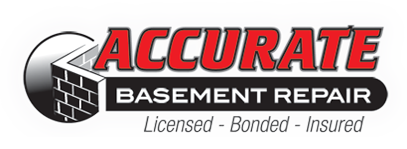Poured Concrete Foundation Walls
Poured concrete foundation walls are considered the way to build in the Milwaukee, Wisconsin area because of the heavy clay soils we have. Clay, when wet, expands and exerts a lot of pressure on the basement walls. Because poured walls are a monolithic structure (one solid piece), they resist the pressure that can cause cinder block walls to bow or the mortar joints to crack, allowing water into the basement. Poured concrete walls, while resisting this ground pressure, do crack from shrinkage and settling. While not affecting the strength of the wall, these cracks may leak water.
The Crack Injection Process
Most active leaking cracks are repaired using a moisture-cured urethane, two package grout. This material reacts with water causing it to foam.
- Injection holes are drilled 4 inches from the crack at a 45 degree angle (this causes the holes to hit the crack in the center of the 8 inch wall.)
- Holes are drilled every 8 to 10 inches and injection ports are placed in the holes.
- The injection process is started from the bottom and works up the wall.
See the crack repair process in this video made by one of our customers
As the urethane grout meets the water, a chemical reaction takes place, generating carbon dioxide, which causes the material to foam and be forced up the crack. The resin forms a high density, closed cell structure that is resistant to water, most chemicals and insects.The excess material is cleaned off the wall, the injection ports are broken off and the holes are patched with concrete. The leak is now stopped.
The urethane injection process is safe and is used in treating concrete water tanks and water lines to prevent ground water contamination. This is also a recognized foundation crack repair method for satisfying building codes and passing home inspections.
Frequently Asked Questions
Why do poured concrete walls crack?
Concrete shrinks as it cures. While many contractors put control joints in the wall, the concrete may crack at stress points like the corner of a window.
Do all cracks have to be filled?
Most builders will only authorize the repair of cracks that are actively leaking. However, if the wall is going to be closed up, it is recommended that all cracks be filled.
Why use urethane instead of epoxy?
All active leaking cracks have to be filled with urethane, as epoxy products will not adhere to a wet crack.
How long will the repair last?
It depends of the age of the wall. Concrete will continue to shrink for up to three years. For new construction, shrinkage could cause the crack to reopen. This is why contractors recommend waiting until downspouts are in place and the landscaping is completed. After a couple of years, the repair will last indefinitely. The cured urethane will not break down.
Can all cracks be repaired by this method?
Yes. We have only had two walls that had to be repaired from the outside. This was thought to be caused by settling, as both were new construction in a questionable area. Cracks can be as small as a hairline or large enough to get your hand in.
I have a crack in my basement wall that has not leaked in 7 years. Should I repair it prior to closing off the wall?
Yes. We have seen cracks that did not leak for years and then started to let in water. This could be caused by a change in gutters, down spouts or grading or just a severe storm. It is best to be on the safe side and repair them.
Will drilling all those holes weaken the wall ?
No. Eight or ten 3/8” holes, 4” deep will not affect the strength of the wall.
Can I still see the crack after it is filled?
Yes. The crack will still be visible. The injection holes will be filled with a cement patch.
Will a building inspector approve this repair?
Yes. This is a recognized repair method for poured walls.
Will this repair make a mess of my basement?
No. There will be some dust from the drilling, however, the dust and bleed out of foam will be cleaned up as part of the job.
Is there any danger with the chemicals used?
No. This is chemically a polyurea. As it reacts with water, carbon dioxide is generated and causes the resin to foam. (Same as bread; yeast causing carbon dioxide to raise the bread). Once cured, the material is inert. This repair method is used for potable water tanks.
How soon will the repair stop the leak?
Within several minutes of starting the injection, the foam will react with the water and seal the crack. The material will be hard to the touch in 3 to 5 minutes.
Why can’t this method be used to fix cinder block foundation walls?
Leaks in block walls are caused when the mortar joints are cracked. This occurs when the wall is moved by pressure from the outside, usually by swelling of the clay soil. The wall may need to be reinforced and/or excavated on the outside and coated with a tar mastic. It could also be as simple as improving your grading, gutters and/or downspouts.
See our “Foundation Crack Injection Repair” blog posts


